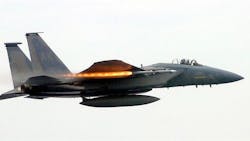Air Force taps Raytheon to build hundreds of radar-guided air-to-air missiles for U.S. military, allies
EGLIN AIR FORCE BASE, Fla. – U.S. military airborne weapons experts are ordering several hundred of the nation's most sophisticated radar-guided air-to-air missiles for the U.S. Air Force, Navy, and military allies under terms of a multi-million-dollar contract announced late last month.
Officials of the Air Force Life Cycle Manager Center at Eglin Air Force Base, Fla., are awarding a $768.3 million contract to the Raytheon Co. Missile Systems segment in Tucson, Ariz., for Lot 33 production of the AIM-120 Advanced Medium Range Air to Air Missile (AMRAAM) for the U.S. and foreign militaries.
AMRAAM is one of the world's most advanced all-weather, all-environment medium range air-to-air missiles. The system is an active radar-guided intercept missile with inherent electronic protection capabilities for air-to-air applications against massed penetration aircraft and is designed to replace the AIM-7 Sparrow air-to-air missile.
This contract involves foreign military sales (FMS) to Australia, Belgium, Canada, Denmark, Indonesia, Japan, Kuwait, Morocco, Netherlands, Norway, Oman, Poland, Qatar, Romania, Saudi Arabia, Singapore, Slovakia, South Korea, Spain, Thailand, Turkey, and the United Kingdom.
The contract includes captive air training missiles, guidance sections, AMRAAM telemetry systems, spare parts, and other production engineering support hardware.
Each AMRAAM lot typically contains between 400 and 500 missiles. The latest version of the missile, the AIM-120D, has improved accuracy via Global Positioning System aided navigation, improved network compatibility, and enhanced aircrew survivability via a two-way data link capability.
The AMRAAM missile has air-to-air and surface-launch versions. In the air-to-air role, the weapon's advanced active guidance section provides the aircrew find targets quickly in challenging environments, Raytheon officials say.
AMRAAM has scored combat victories in Iraq, Bosnia, and Kosovo, Raytheon says. It uses digital technology, micro-miniaturized solid-state electronics, and active radar guidance for air combat and air defense.
Related: Can U.S. air-to-air missiles stand up to modern enemy electronic warfare?
AMRAAM provides multi-shot capability, and can be launched day or night, in all weather conditions. Its autonomous guidance capability provides the pilot with launch-and-leave ability to provide fast engagement of follow-on targets or the option to fire first and then run from targets.
AMRAAM's capabilities include quick fly-out, immunity to countermeasures, and the ability to reject radar clutter to attack low-altitude targets. The missile has active radar guidance, multi-shot capability, and the ability to launch from aircraft or from surface-to-air missile sites.
Raytheon also is developing the AMRAAM Extended Range missile for ground-based air defense, AMRAAM-ER will enable intercepts at longer distances and higher altitudes.
Procured by 36 countries, the AMRAAM has been integrated onto the F-16, F-15, F/A-18, F-22, Typhoon, Gripen, Tornado, and Harrier combat jets. The AIM-120C5 and AIM-120C7 are being integrated onto the F-35 Joint Strike Fighter.
On this contract Raytheon will do the work in Tucson, Ariz., and should be finished by February 2023. For more information contact Raytheon Missile Systems online at www.raytheon.com, or the Air Force Life Cycle Management Center at www.aflcmc.af.mil.

John Keller | Editor-in-Chief
John Keller is the Editor-in-Chief, Military & Aerospace Electronics Magazine--provides extensive coverage and analysis of enabling electronics and optoelectronic technologies in military, space and commercial aviation applications. John has been a member of the Military & Aerospace Electronics staff since 1989 and chief editor since 1995.

